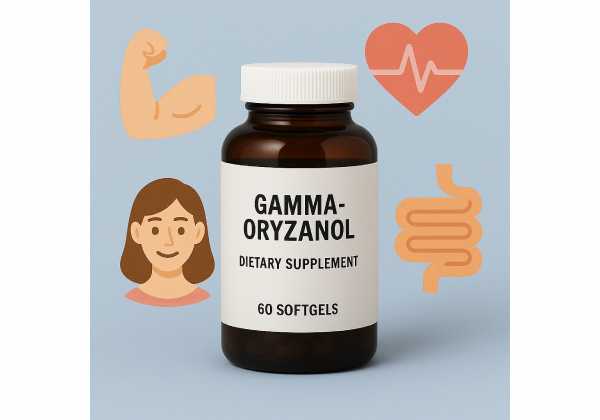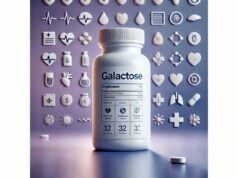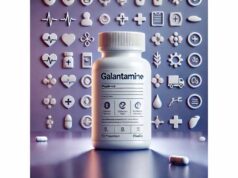
Gamma-oryzanol is a group of antioxidant compounds naturally concentrated in rice bran oil. It has drawn interest for cardiovascular support, metabolic health, and midlife symptom relief, along with long-standing (and often overstated) claims in sports nutrition. In this guide, you will learn what gamma-oryzanol is, how it works, what the human studies actually show, how to use it wisely, and who should avoid it. We will translate technical details into practical, step-by-step advice—covering typical dosing from cooking oils and supplements, timing, and ways to combine it with diet and lifestyle for better results. You will also see where evidence is strong, where it is mixed, and where it is weak or missing, so you can make informed, safe choices.
Key Insights
- May improve LDL cholesterol, triglycerides, and select glycemic markers when delivered via enriched cooking oils.
- Limited support for menopausal symptom relief; evidence strongest when combined with standard therapy.
- Practical intake spans ~30–300 mg/day from fortified oils or ~100–300 mg/day in capsules; short trials used up to 600 mg/day.
- Avoid during pregnancy or breastfeeding and if you have hormone-sensitive cancers or a rice allergy.
Table of Contents
- What is gamma-oryzanol?
- Benefits: what do studies show?
- How to take gamma-oryzanol
- What affects results?
- Is it safe and who should avoid it?
- Evidence summary and research gaps
What is gamma-oryzanol?
Gamma-oryzanol (often written γ-oryzanol) is a naturally occurring blend of molecules found in the “unsaponifiable” fraction of rice bran oil. Chemically, it consists of ferulic acid bound to plant sterols and triterpene alcohols—most famously cycloartenyl ferulate, 24-methylene-cycloartanyl ferulate, and campesteryl ferulate. These compounds act as lipid-soluble antioxidants and appear to modulate how cholesterol and fatty acids are processed in the body. Because gamma-oryzanol is fat-soluble, it is typically delivered in an oil matrix (such as rice bran or canola oil fortified with gamma-oryzanol) or encapsulated as a dietary supplement.
Why people take it
- Cardiometabolic support. Interest began with rice-eating populations and expanded when small randomized trials suggested improvements in LDL cholesterol, triglycerides, and markers of oxidative stress.
- Menopausal comfort. In Japan and parts of East Asia, gamma-oryzanol has been used for climacteric complaints; recent controlled data explore it alongside standard hormone therapy.
- Sports claims. Bodybuilding communities popularized gamma-oryzanol decades ago for strength and anabolic effects. Controlled trials, however, have not consistently confirmed these claims.
How it may work (in plain language)
- Antioxidant buffering. The ferulate backbone helps neutralize reactive oxygen species within lipid membranes, potentially protecting LDL particles from oxidation.
- Lipid handling. By interacting with enzymes and transcription factors involved in fatty-acid synthesis and cholesterol transport, gamma-oryzanol may nudge lipids toward a healthier profile.
- Cell-signaling effects. Lab models suggest anti-inflammatory effects; the clinical significance depends on dose, delivery, and study population.
Practical sources
- Rice bran oil (RBO). Naturally contains gamma-oryzanol; some trials used daily portions of RBO with differing gamma-oryzanol concentrations.
- Fortified edible oils. Canola oil fortified to ~1 mg gamma-oryzanol per gram has been studied.
- Capsules. Over-the-counter products commonly provide 50–150 mg per capsule; research doses range more widely.
Bottom line: gamma-oryzanol is a plausible cardiometabolic adjunct found in certain edible oils, with additional exploratory uses. Its benefits depend strongly on how it is delivered and at what dose.
Benefits: what do studies show?
Lipid profile and antioxidant status
Randomized, controlled human research using rice bran oil enriched with gamma-oryzanol has shown meaningful changes in LDL cholesterol and antioxidant capacity over short periods. In one representative trial, adults with elevated lipids replaced their cooking oil with rice bran oil for four weeks; groups consumed oils containing roughly 0.4%, 0.8%, or 1.1% gamma-oryzanol (equating to about 110–300 mg/day if ~30 mL oil was used daily). LDL cholesterol fell more in the rice-bran-oil groups than in the soybean-oil control, with the higher-oryzanol oils producing the largest LDL reductions. Markers of antioxidant status improved as well. These results support a modest LDL-lowering and antioxidant benefit—when the compound is consumed within an oil matrix and with consistent daily intake.
Glycemic markers and blood pressure
A 12-week randomized trial in adults with type 2 diabetes compared household use of: (1) canola oil fortified with gamma-oryzanol (about 1 mg per gram of oil), (2) unfortified canola oil, or (3) sunflower oil. While all groups saw some improvements (likely from replacing less healthy fats), only the gamma-oryzanol–fortified canola group showed statistically significant drops in fasting glucose, HbA1c, and triglycerides, alongside reductions in waist circumference and blood pressure. Because oil intake was integrated into normal cooking (roughly 30 g/person/day provided), these findings are clinically relevant for everyday use—but they also reflect a bundled effect of both oil type and gamma-oryzanol fortification.
Menopausal and perimenopausal symptoms
Evidence here is emerging and nuanced. A 2024 controlled study evaluated gamma-oryzanol added to standard menopausal therapy (Femoston). The combination outperformed hormone therapy alone on symptom scores, sleep measures, bone density metrics, and selected hormone levels. This suggests gamma-oryzanol may play a supportive role when used with established treatments. On its own, the modern evidence base remains limited; older, small or uncontrolled studies are not definitive. If menopausal comfort is your priority, think of gamma-oryzanol as a potential adjunct your clinician might consider—not a replacement for guideline-directed care.
Weight, body composition, and appetite
Human trials focused on lipids and glycemic control do not show reliable, clinically important weight loss attributable to gamma-oryzanol. Changes in waist circumference often track with overall dietary pattern and oil substitution. Animal and mechanistic studies suggest possible appetite or preference effects, but this has not translated into robust human outcomes.
Athletic performance
Claims of enhanced strength or anabolic effects have not held up consistently in controlled settings. An older double-blind study using 500 mg/day for nine weeks in resistance-trained adults did not find meaningful performance or physiological advantages over placebo. Overall, the evidence does not support gamma-oryzanol as an ergogenic aid.
How to interpret mixed findings
- Delivery matters: benefits are more consistent when gamma-oryzanol is consumed in an oil used daily for cooking rather than as occasional capsules.
- Duration is short in most trials (4–12 weeks). We lack long-term data on hard outcomes.
- Results vary by population (e.g., type 2 diabetes versus generally healthy adults).
What this means for you: for lipid and glycemic support, consider dietary oil strategies that include gamma-oryzanol rather than relying solely on capsules; for menopausal symptoms, discuss adjunct use with your clinician; for performance, seek better-supported options.
How to take gamma-oryzanol
Decide on your route: cooking oils vs. capsules
- Fortified edible oils (everyday use). If you regularly cook at home, using an oil that naturally contains or is fortified with gamma-oryzanol is the most “set-and-forget” approach. Trials have used oils with ~1 mg gamma-oryzanol per gram (fortified canola) or rice bran oil with 0.4–1.1% gamma-oryzanol. When people used ~30 g/day of the study oil, estimated gamma-oryzanol intake ranged from ~30 mg/day (fortified canola) to ~110–300 mg/day (rice bran oil, depending on concentration).
- Capsules (measured dosing). Many supplements provide 50–150 mg per capsule. A practical starting range for adults is 100–300 mg/day, taken with meals containing fat to aid absorption. Small trials exploring strength used 500–600 mg/day for about 9 weeks; cardiometabolic studies using enriched oils approximated 30–300 mg/day.
Dosing suggestions by goal (evidence-aligned)
- Lipid and glycemic support: prioritize daily oil intake. Aim for ~30 g/day of a gamma-oryzanol–containing oil (as part of an overall heart-healthy pattern). If using capsules instead, consider 100–300 mg/day with meals for 8–12 weeks, then reassess labs.
- Menopausal symptom adjunct: discuss with your clinician. If used, a cautious capsule range of 100–300 mg/day with food may be considered alongside standard therapy.
- Athletic performance: evidence is insufficient; if tried, avoid exceeding 600 mg/day and do not expect anabolic effects.
Timing and administration
- Take with meals that include fat to support absorption.
- Split doses (e.g., morning and evening) if using ≥200 mg/day.
- Keep your total dietary fat pattern in view: oil substitution (not addition) helps avoid excess calories.
How long to try
- Re-evaluate after 8–12 weeks with objective markers (lipid panel, fasting glucose/HbA1c if relevant, symptom scores). Continue only if you see a tangible benefit and tolerate it well.
Smart combinations
- With diet: pair with Mediterranean-style patterns (vegetables, legumes, whole grains, fish) to magnify lipid and glycemic benefits.
- With exercise: combine with regular aerobic and resistance training for cardiometabolic outcomes; do not rely on supplements alone.
- With other supplements: be careful with multi-ingredient “cholesterol” products (e.g., those combining red yeast rice/monacolins). Overlapping effects can complicate safety and make it hard to attribute benefits or side effects.
Quality and storage
- Choose reputable brands for capsules; look for standardized gamma-oryzanol content.
- Store oils away from heat and light; buy in quantities you will finish in 1–3 months.
- For cooking, prefer moderate-heat methods; very high heat can degrade sensitive components in any oil.
When to stop
- If you develop rash, hives, itching, unusual headaches, or digestive upset that persist.
- If menopausal symptoms worsen or if you notice menstrual irregularities outside expected therapy plans.
- If lab markers do not improve after 12 weeks despite good adherence.
What affects results?
1) Delivery matrix (oil vs. capsule)
Fat-soluble compounds often absorb more reliably when consumed with dietary fat. Trials that replaced household oils with gamma-oryzanol–containing oils reported clearer changes in LDL, triglycerides, and glycemic markers than many capsule-only studies. The oil vehicle likely supports absorption and ensures consistent daily exposure without additional effort.
2) Daily dose and consistency
Estimated intakes of ~30–300 mg/day have been associated with biomarker changes when adhered to over 4–12 weeks. Very low or inconsistent intakes (e.g., sporadic capsule use) may not move the needle. Conversely, higher capsule-based doses (500–600 mg/day) have not produced reliable performance benefits.
3) Baseline biology
People with higher baseline LDL, elevated triglycerides, insulin resistance, or type 2 diabetes tend to show bigger absolute changes in short trials. Those already at goal on optimal diet and medications may see modest or no additional benefit.
4) Whole-diet context
Substituting an oil within a heart-healthy dietary pattern (more fiber, fewer refined carbs, attention to energy balance) yields better outcomes than simply adding oil on top of existing calories. Improvements in waist circumference and blood pressure often track with overall diet quality and weight changes.
5) Heat and handling
As with all edible oils, prolonged high-heat cooking degrades sensitive components. For oils rich in bioactives, prefer sautéing, baking, or dressings over deep-frying. Keep bottles sealed, cool, and away from light.
6) Product variability
Natural and fortified oils differ in gamma-oryzanol content. Supplement capsules can vary in standardization and purity. Verify labels, batch testing where available, and avoid products making sweeping, curative claims.
7) Concomitant therapies
In perimenopausal studies, gamma-oryzanol is being explored with standard therapy rather than instead of it. For lipids and glucose, medications (statins, ezetimibe, metformin) remain first-line where indicated. Supplements are adjuncts; always align with your clinician’s plan.
8) Expectations and endpoints
Short trials measure surrogate markers (LDL, triglycerides, HbA1c, antioxidant status)—not long-term events like heart attack or fracture risk. Benefits, where present, are typically modest and should be interpreted alongside diet and lifestyle.
Takeaway: choose a delivery method you can sustain, track objective outcomes, and integrate gamma-oryzanol into a broader cardiometabolic or symptom-management strategy rather than treating it as a standalone fix.
Is it safe and who should avoid it?
General tolerability
Short-term trials (4–12 weeks) using fortified oils (~30–300 mg/day estimated intake) and capsule doses up to 600 mg/day have generally reported good tolerability without serious adverse events. Mild digestive discomfort or headache is possible with any new supplement or change in oil intake.
Potential side effects
- Gastrointestinal: fullness, mild nausea, loose stools (especially if total oil intake increases).
- Headache or light dizziness (uncommon).
- Skin reactions (rare; consider rice or additive sensitivity).
Medication and condition cautions
- Pregnancy and breastfeeding: insufficient safety data—avoid.
- Hormone-sensitive conditions: given exploratory effects on hormone-related symptoms and limited human data, avoid with a history of estrogen-sensitive cancers unless your oncology team approves.
- Allergies: avoid if allergic to rice or rice-bran products.
- Lipid-lowering drugs: no well-documented direct interactions, but if you use multi-ingredient “cholesterol” supplements (e.g., those with red yeast rice/monacolins), combining with gamma-oryzanol complicates monitoring; review with your clinician.
- Surgery: like most supplements, stop 1–2 weeks before planned procedures unless your surgical team advises otherwise.
Lab monitoring and “stop rules”
- For lipid or glycemic goals, check panels at baseline and after 8–12 weeks. Continue only if benefits outweigh cost and complexity.
- Stop if you develop persistent adverse effects, unexplained rash, or if your clinician identifies lab changes of concern.
Special populations
- Children and adolescents: no robust data; do not use unless prescribed for a specific indication by a pediatric clinician.
- Older adults with polypharmacy: review for duplicate lipid-lowering strategies and ensure oils fit within calorie needs.
Quality and contamination
Choose products from manufacturers with third-party testing where possible. For oils, prefer reputable brands and look for freshness dating. Do not overstock; buy sizes you can finish promptly to minimize oxidation.
Bottom line: short-term use appears well-tolerated for most adults, particularly when delivered via everyday cooking oils. Use more caution if you have hormone-sensitive conditions, are pregnant or breastfeeding, or have food allergies.
Evidence summary and research gaps
What is well-supported?
- LDL and antioxidant capacity: When people replace usual cooking fats with rice bran oil containing moderate-to-higher concentrations of gamma-oryzanol for several weeks, LDL cholesterol and antioxidant markers can improve. The effect size is modest but consistent in small, well-controlled studies.
- Everyday feasibility: Fortified oils that fold into normal meals may boost adherence and produce real-world changes in waist circumference, triglycerides, and glycemic markers—especially in type 2 diabetes.
What is promising but preliminary?
- Glycemic control and blood pressure: A fortified-oil trial in adults with diabetes reported significant improvements in fasting glucose, HbA1c, and blood pressure only in the gamma-oryzanol–fortified group. Replication in diverse settings and with more precise intake quantification is needed.
- Menopausal symptom support: A 2024 controlled study showed that adding gamma-oryzanol to standard hormone therapy improved symptom control and certain bone and hormone indices versus therapy alone. Larger, longer trials—including gamma-oryzanol monotherapy arms—are required before routine recommendations.
What is not supported?
- Ergogenic/anabolic effects: Controlled data do not support meaningful performance enhancement or anabolic outcomes. If performance is your goal, invest in training, nutrition periodization, sleep, and evidence-based supplements (e.g., creatine monohydrate) under professional guidance.
Where do results conflict?
- Whole rice bran vs. rice bran oil vs. fortified oil: A 2023 GRADE-assessed meta-analysis of whole rice bran found no significant impact on lipid profiles across randomized trials. This contrasts with some oil-based interventions, highlighting that matrix and dose matter.
- Dose clarity: Fortified-oil trials often estimate, rather than fix, gamma-oryzanol intake based on household use, leaving some uncertainty about true dose-response.
Key gaps to fill
- Long-term outcomes: We lack data on cardiovascular events, fracture risk, or durable menopausal benefits.
- Standardized dosing: Trials using fixed, labeled doses in capsules or pre-metered oils will clarify minimal effective and upper safe intakes.
- Mechanism in humans: Translational studies that link changes in lipid handling or inflammation to clinical endpoints will strengthen causal claims.
- Population diversity: Most trials are small and regionally concentrated; broader representation is needed.
Practical verdict
- If your goal is cardiometabolic support, consider a food-first approach using an oil with gamma-oryzanol as part of a comprehensive dietary pattern; track objective markers.
- For menopausal symptoms, position gamma-oryzanol—if used at all—as a clinically supervised adjunct.
- Skip it for performance enhancement.
- Use clear “stop rules,” and keep expectations realistic: benefits, where present, are generally modest.
References
- Daily consumption of γ-oryzanol-fortified canola oil, compared with unfortified canola and sunflower oils, resulted in a better improvement of certain cardiometabolic biomarkers of adult subjects with type 2 diabetes: a randomized controlled clinical trial 2023 (RCT)
- Rice Bran Oil Containing Gamma-Oryzanol Improves Lipid Profiles and Antioxidant Status in Hyperlipidemic Subjects: A Randomized Double-Blind Controlled Trial 2019 (RCT)
- The effects of rice bran supplementation for management of blood lipids: A GRADE-assessed systematic review, dose–response meta-analysis, and meta-regression of randomized controlled trials 2023 (Systematic Review)
- Clinical efficacy of gamma-oryzanol combined with Femoston for perimenopausal syndrome 2024 (Controlled Study)
- The effects of gamma-oryzanol supplementation during resistance exercise training 1997 (RCT)
Disclaimer
This article provides general information for educational purposes and is not a substitute for personalized medical advice, diagnosis, or treatment. Supplements can interact with health conditions and medications. Always consult your physician or qualified health professional before starting, stopping, or changing any supplement, diet, or medication. If you are pregnant, breastfeeding, planning surgery, or have hormone-sensitive conditions, seek professional guidance first.
If you found this helpful, consider sharing it on Facebook, X (formerly Twitter), or your favorite platform, and follow us for future evidence-based guides. Your support helps us keep creating high-quality, reader-first content.










